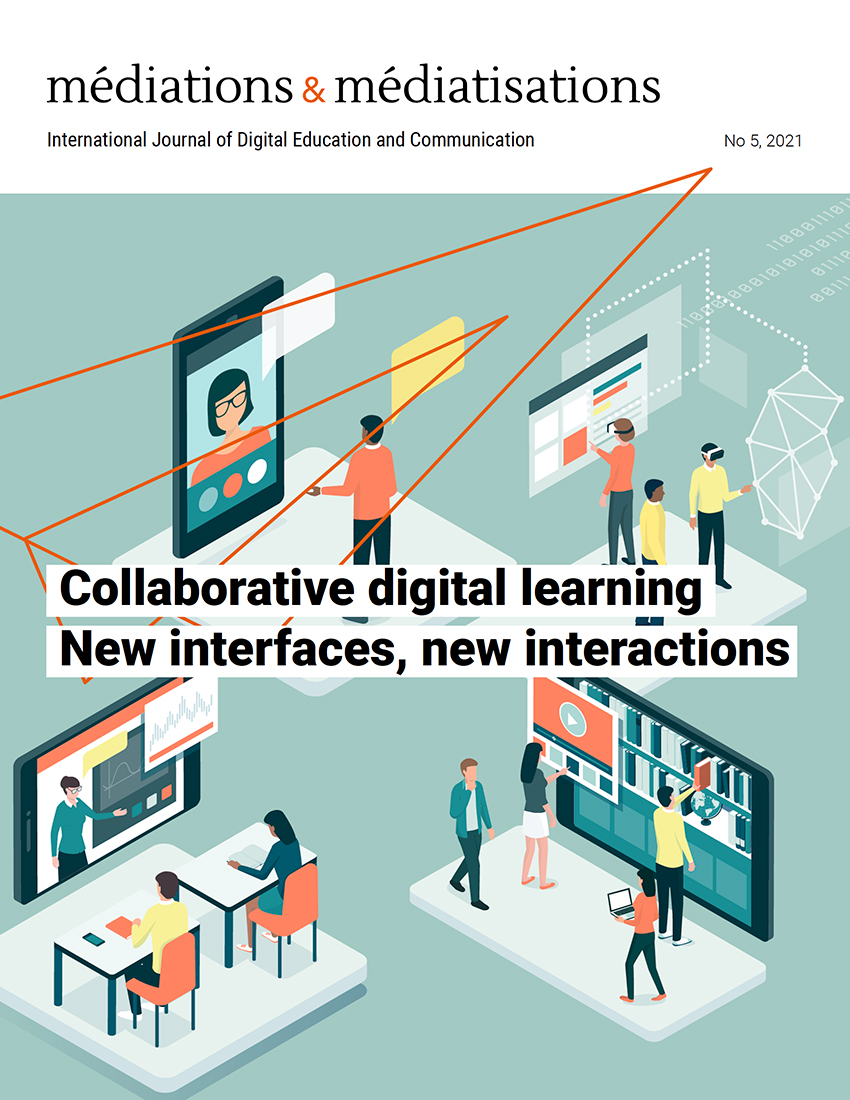Collective work and uses of digital technology: What categorization of practices among French teachers at school and college?
Main Article Content
Abstract
As part of the e-TAC project "Tangible and Augmented Environments for Collaborative Learning", a questionnaire survey was conducted online among teachers of cycles 3 and 4 in Moselle (France) to better describe their collective work practices peers and in class, with or without digital technology. By analyzing the 972 responses obtained, we address two main questions: What are the categories of practices declared by teachers and the place of digital tools and resources in them? On what depends on the frequency of group work by their students at school and college? Our statistical processing of data on school and college teachers' practices allowed us to identify four categories of variables associated with the groups' practices. Results show they are aggregated along two paradigmatic axes (teacher/learner, self-centred/heterocentric). On the other hand, the analysis of the predictive power of six categories of group work variables shows that the impact of the use of digital tools and resources ultimately proves to be very secondary.
Downloads
Article Details

This work is licensed under a Creative Commons Attribution-NonCommercial-ShareAlike 4.0 International License.
References
Baudrit, A. (2007). La formation des enseignants aux méthodes d’apprentissage coopératif : perspectives internationales. Savoirs, 14, 73-92.
Butori, R., et Parguel, B. (2010). Les biais de réponse-Impact du mode de collecte des données et de l'attractivité de l'enquêteur. Actes du 26e Congrès international de l'AFM, Le Mans-Angers, France.
Cerisier, Jean-F. (2016). La forme scolaire à l’épreuve du numérique. In Bonfils, P., Dumas, P. et Massou, L., dirs. Numérique et éducation. Dispositifs, jeux, enjeux, hors jeux. Nancy, PUN-Editions Universitaires de Lorraine, 195- 210.
Cerisier, J-F. (2020). Faut-il renoncer au numérique pour l’éducation? The Conversation France, 18 juin. https://theconversation.com/faut-il-renoncer-au-numerique-pour-leducation-140765
Conein, B. (2004), Communautés épistémiques et réseaux cognitifs: coopération et cognition distribuée. Revue d’économie politique, 113, 141-159.
Cristol, D. (2017). Les communautés d’apprentissage : apprendre ensemble. Savoirs, 43(1), 10-55.
Cristol, D. (2016). Peut-on créer des communautés d’apprentissage? Éducation permanente, 207, 155-163. Dillenbourg, P. (1999). « What do you mean by collaborative learning? ». In Dillenbourg P., dir. Collaborative-learning: Cognitive and Computational Approaches. Oxford : Elsevier, 1-19.
Dupriez, V. (2010). Le travail collectif des enseignants : au-delà du mythe. Travail et formation en éducation, 7. http://journals.openedition.org/tfe/1492
Gibert, A-F. (2018). Le travail collectif enseignant, entre informel et institué. Dossier de veille de l’IFÉ, 124. Lyon : ENS de Lyon. http://veille-et-analyses.ens-lyon.fr/DA/detailsDossier.php?parent=accueil&dossier=124&lang=fr
Giraudeau, P., Olry, A., Roo, J. S., Fleck, S., Bertolo, D., Vivian, R. and Hachet, M. (2019). CARDS: A Mixed-Reality System for Collaborative Learning at School. In Proceedings of the 2019 ACM International Conference on Interactive Surfaces and Spaces, 55-64
Jouët, J. (2000). Retour critique sur la sociologie des usages. Réseaux, 100(18), 487-521.
Lê, S., Josse, J. et Husson, F. (2008). FactoMineR: An R Package for Multivariate Analysis. Journal of Statistical Software, 25(1), 1-18.
Lessard, C., Kamanzi, P. et Larochelle, M. (2009). De quelques facteurs facilitant l'intensification de la collaboration au travail parmi les enseignants : le cas des enseignants canadiens. Éducation et sociétés, 23(1), 59-77.
Loup-Escande, E., Dominjon, L., Perret, D., Erhel, S., Jamet, E., Michinov, N., Andriot, C., Gravez, P. and Ragot, M. (2013). La démarche de Conception Centrée-Utilisateur en Réalité Virtuelle: l’exemple du projet VirtualiTeach. In Journées de l’Association Française de Réalité Virtuelle.
Marcel, J., Dupriez, V. et Périsset Bagnoud, D. (2007). Le métier d'enseignant : nouvelles pratiques, nouvelles recherches. In Marcel, J-F., dir. Coordonner, collaborer, coopérer: De nouvelles pratiques enseignantes. Louvain-la-Neuve : De Boeck Supérieur, 7-17.
Maubant, P. (2014). Le travail collectif enseignant : allant de soi, effet de mode convenu ou analyseur décalé de la professionnalité enseignante? Questions Vives, 21. http://journals.openedition.org/questionsvives/1514
Mevik, B-H., Wehrens, R. et Hovde Liland, K. (2019). Pls : Partial Least Squares and Principal component Regression. R package version 2.7-1. https://CRAN.R-project.org/package=pls
Ministère de l’Éducation nationale. (2017). Rapport complet PROFETIC (1er degré). https://eduscol.education.fr/cid60867/l-enquete-profetic.html
Ministère de l’Éducation nationale. (2018). Rapport PROFETIC. https://eduscol.education.fr/cid60867/l-enquete-profetic.html
Norman, D. A. and Draper, S. W. (1986). User Centered System Design; New Perspectives on Human-Computer Interaction. NJ, USA : L. Erlbaum Assoc. Inc., Hillsdale.
Orellana, I. (2005). L’émergence de la communauté d’apprentissage ou l’acte de recréer des relations dialogiques et dialectiques de transformation du rapport au milieu de vie. In L. Sauvé, L., Orellana, I. et Van Steenberghe, E., dirs. Éducation et environnement. Un croisement de savoirs. Cahiers scientifiques de l’Acfas, 104, 67-84.
Oviatt, S. (2006). Human-centered design meets cognitive load theory: designing interfaces that help people think. In Proceedings of the 14th ACM international conference on Multimedia, 871-880.
Poteaux, N. (2017). Usage des outils numériques : croyances et connaissances des enseignants. In Massou, L. et Lavielle- Gutnik, N., dirs. Enseigner à l'université avec le numérique : Savoirs, ressources, médiations. Louvain-la-Neuve : De Boeck Supérieur, 21-41.
Reuter, Y., Cohen-Azria, C., Daunay, B., Delcambre, I. and Lahanier-Reuter, D. (2010). Dictionnaire des concepts fondamentaux des didactiques. Bruxelles : De Boeck Université.
Tenenhaus, M. (1998). La régression PLS : Théorie et pratique. Paris : Editions TECHNIP.
Tondeur, J., Hermans, R., van Braak, J., et Valcke, M. (2008). Exploring the link between teachers’ educational belief profiles and different types of computer use in the classroom. Computers in Human Behavior, 24(6), 2541-2553.
Trudel L., Simard C. et Vonarx N. (2007). La recherche qualitative est-elle nécessairement exploratoire? Recherches qualitatives, hors série, 5, 38-45.
Spillane J., Shirrell M. et Hopkins M. (2016). Designing and deploying a Professional Learning Community (PLC) organizational routine: Bureaucratic and collegial arrangements in tandem. Les dossiers des sciences de l’éducation, 35, 97-122.
Vangrieken, K., Dochy, F., Raes, R. et Kyndt, E. (2015). Teacher collaboration: A systematic review, Educational Research Review, 15, 17-40.
Vangrieken, K., Dochy, F. et Raes, E. (2016). Team learning in teacher teams: team entitativity as a bridge between teams-in-theory and teams-in-practice. European Journal of Psychology of Education, 31.
Vigneau, E., Chen M. et Qannari, E.M. (2015). ClustVarLV: An R Package for the Clustering of Variables around Latent Variables. R Journal, 7(2), 134-148.

